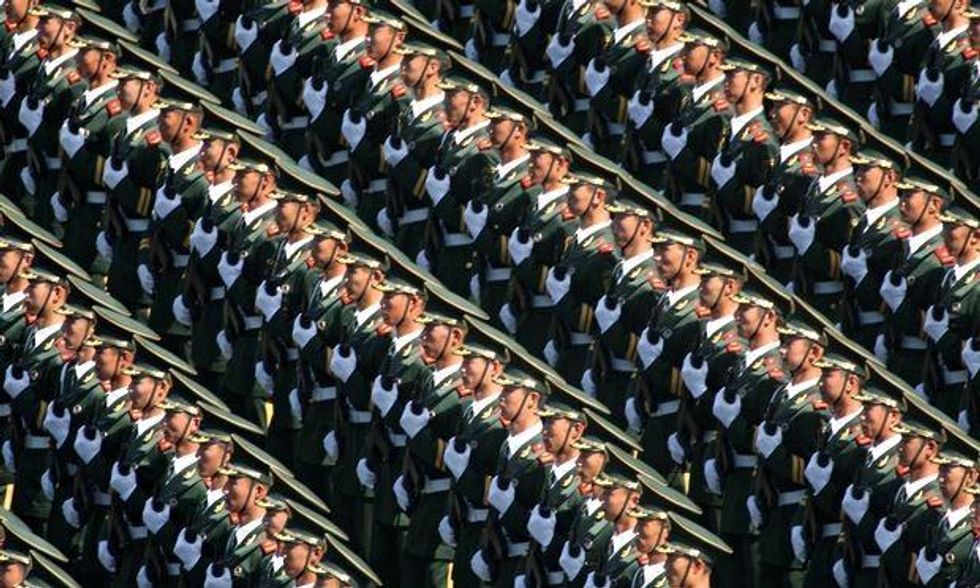There are few surprises about the distribution of military spending: for all the current focus on China's growing military outlays - and it is significant that they have embarked on a sequence of double-digit increases as a percentage of GDP - the United States still accounts for 40% of such expenditures. However, the distribution is not the only thing that matters; it's the sheer scale of such investment - $1.756tn in 2012. The "peace dividend" from the end of the cold war has long since bitten the dust. Global military spending has returned to pre-1989 levels, undoubtedly a legacy of the war on terror and the returning salience of military competition in its context. In fact, by 2011 global military spending was higher than at any year since the end of the second world war.
So, what is the explanation for such huge investments? Is it simply the case that states are power-maximising entities, and that as soon as they have access to enough taxable income they start dreaming war?
In a very general sense, militarisation could be seen as an integral aspect of capitalism. One of the central ambiguities of capitalism is that it is necessarily a global system, with production and exchange extending beyond national boundaries; yet at the same time, units of capital (corporations etc) tend to be concentrated within national states where they are afforded an infrastructure, a labour force, and a great deal of primary investments. Even the process of globalisation presupposes the investment and guidance of national states. The more deeply companies are intertwined with national states, the more they rely on those states to fight their competitive battles on a global stage. Maintaining a military advantage is arguably an intrinsic part of this.
However, once this rather abstract principle is established, the question still remains unanswered. After all, there is no inherent reason why geo-economic competition should lead to defence spending consuming trillions of dollars of value each year. Part of the answer has to be located in the way that high levels of military spending became such an entrenched part of the global landscape in the aftermath of two world wars.
In the context of the second world war, and then in the subsequent cold war, one thing about military spending that became abundantly clear is that it is never just about conflict. As in the conduct of wars themselves, the institutionalisation of military spending quickly becomes entangled in a series of incentives that are entirely tangential to the ostensive motive.
First of all, states that do embark on large scale military investment quickly assume strategic command of core sectors of the economy, allowing for a degree of planning and co-ordination, a level of state capacity that might otherwise be deplored by business as "socialism". Quite a lot of the major US technological advances made under the rubric of "free enterprise", including particularly Apple's innovations, owe themselves originally to state investments organised under the banner of "defence".
Second, military investment is not just an effect of economic growth, but often a lever in enhancing it. This is a complicated story in itself. Post-war US growth was probably enhanced by arms spending, but the levels of spending required during the Vietnam war sapped too much capital away from other profitable investments. By the same token, it is not clear whether Japan's rise to becoming a major global economic power would have been possible had its military commitments not been constitutionally limited.
Nonetheless, there is some complex evidence of arms spending increasing growth. Barry Rundquist and Thomas Carsey's study of military procurement in the United States demonstrates that this has a distributive aspect. Such spending in the US helps already wealthy, booming locales become even wealthier, but it does not tend to make poor areas wealthier and nor does it reduce unemployment. This is quite significant, because one of the major arguments governments offer for protecting military spending is that it protects jobs - the one situation in which governments almost always feign an interest in employment. There is actually little evidence for this claim.
That brings us to a final point. There is no way to discuss the real dimensions of military competition without looking at how this is represented for particular audiences. One thinks of the way in which struggles over arms spending in the US become inflected with evocations of external threats, which help consolidate domestic power blocs. The Reaganite-era neo-conservative bloc was impossible without an elevated Russian "threat". So, particularly in states with an imperialist role, military spending can become complexly bound up not only with state-building strategies and agendas for regional economic growth, but also with domestic hegemonic strategies in which the legitimacy of governments hinges upon their ability to project violence.
To this extent, to really understand world arms spending it is necessary to penetrate beneath the generalities about sui generis state behaviour, as power-maximisers and so on, and delve into the messy politics of militarism in each society.


